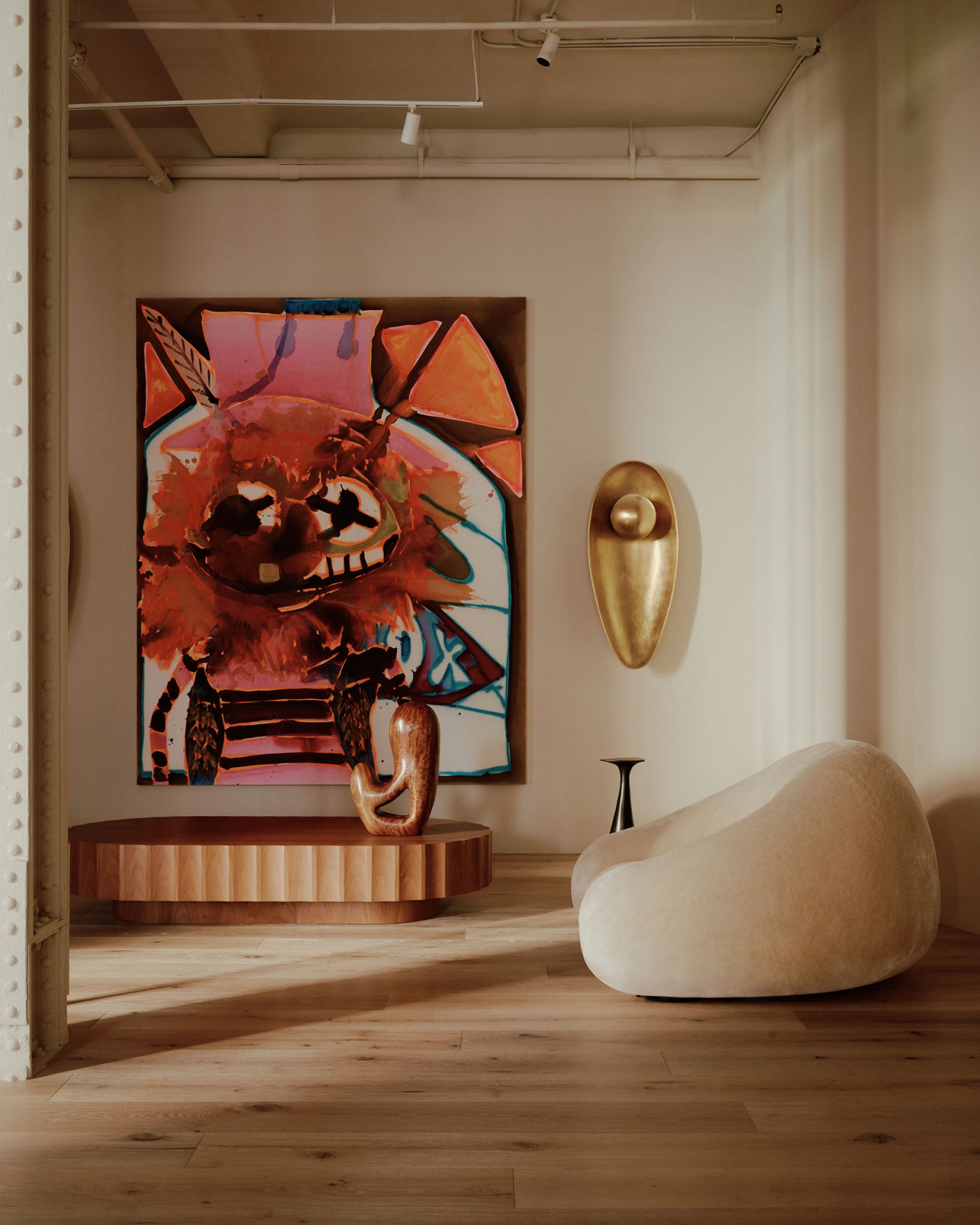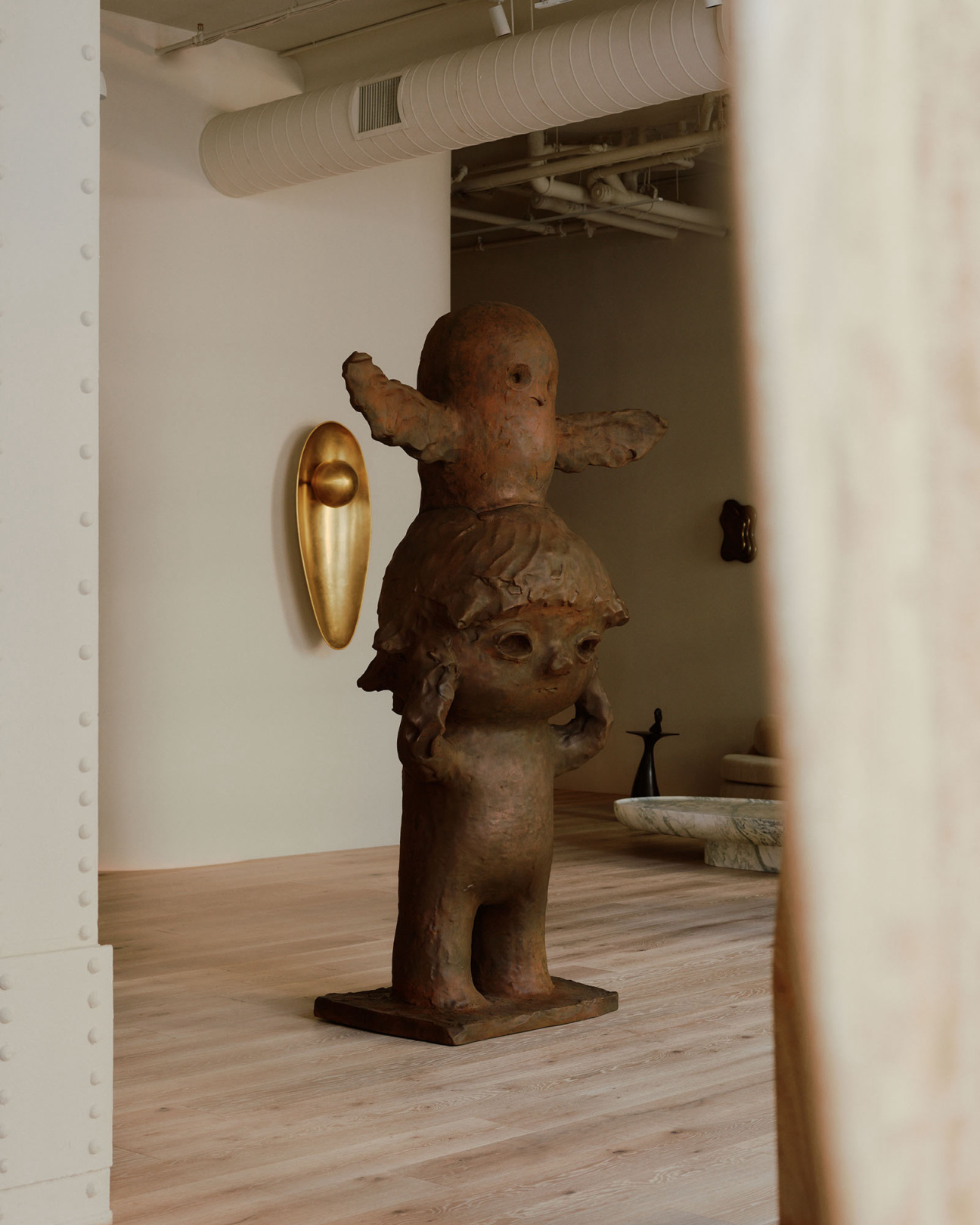
How does a gallerist balance making professional artwork selections with acquisitions for their personal collection? When it comes to STUDIOTWENTYSEVEN founders Nacho Polo and Robert Onuska, the line is beautifully blurred.
Polo and Onuska have a long-standing appreciation for contemporary art and design, the former getting his start crafting interiors in Europe and Miami, where the pair have an additional gallery space. STUDIOTWENTYSEVEN's appointment-only New York branch is the latest iteration of that devotion, having only opened its doors last February.
The idea of living with work—or enjoying the work where it lives best—is paramount for the collectors, who have intermingled a number of their large-scale acquisitions by Paola Pivi, Katherine Bernhardt, and others with the wider selection of work on view in Tribeca. At home, further pieces by the likes of André Butzer, Louise Nevelson, and Hans Josephsohn line the couple's bedroom walls.
Below, Polo and Onuska spoke with CULTURED about the settling into the New York scene, their collecting ethos, and playing the primary market.
Where does the story of your personal collection begin?
Our collection began when we started working on the interior of our new apartment in Tribeca. We wanted to add a few works to our home and life. Little did we know that “adding a few works” would evolve into a much deeper appreciation for art and how it becomes part of our everyday life.

How do you decide which pieces stay in the home and which go to the gallery? Is there a certain type of artwork that you find yourself most drawn to living with?
Our art is placed where we can enjoy it, either at home or in one of our galleries. All the work in our collection rotates and travels between different locations. Many of the artworks we have at our New York gallery were previously at one of our homes—other works were already at our Miami gallery. A few of the works, such as the sculptures by Paola Pivi and Otani Workshop, and Katherine Bernhardt’s painting Dr. Teeth and Doritos, have only lived at the New York gallery. These works are so large in scale, we had to keep them in storage for over a year, until we were able to finally install them in the New York space.
We are currently in the process of designing our gallery in London which will also be able to accommodate larger works. Paola Pivi’s sculpture, currently in our New York gallery, will cross the Atlantic and be installed there for the opening. We love living with every single artwork we have acquired. Although they are all individually very different, we have noticed a few common themes as we’ve built our collection; many are animated, many are vibrant in color, and much to our surprise, we have many sculptures.
What is the first piece you ever bought?
Marilyn Minter's Wet Kiss, 2014. The scale is very large and makes a strong, powerful statement. It is also one of the few photography works we have in our collection at the moment.

Which work or works provokes the most conversation from visitors?
Our visitors respond differently to the art on view throughout our gallery, but the sculptures by Paola Pivi and Otani Workshop solicit the most comments due to their large scale, animation, or color. Visitors can’t help but react to Katherine Bernhardt’s museum-size painting with its scale, vibrant color, and of course, its subject matter—The Muppets and Doritos—which always elicits a smile.
More serene and calm works, such as our paintings by Jana Schröder and Torkwase Dyson, are also received with interest, but for very different reasons. They are bold in their minimalism and lack of color. We feel this contrast in the curation is what makes the experience of visiting the gallery so special.
Which artist are you currently most excited about and why?
We are always excited when we acquire a new piece of art. At the moment our attention is focused on Rashid Johnson and Yoshitomo Nara. We have long been interested in Johnson’s work and spent years searching for the perfect piece to add to our collection. We finally found the perfect one for us in Untitled Anxious Bruise Drawing, 2021.
We’re also looking forward to installing a work by Nara at our New York home. We’ve been thinking about the work, Untitled, 2000, since his last show, "The Bootleg Drawings 1988-2023," in Geneva. Its inclusion in this exhibition has added to our excitement. Another work that generated a lot of excitement was our first sculpture from Claudia Comte, Fire Coral, 2019, which we loaned to the Thyssen-Bornemisza Museum, in Madrid, for Comte’s exhibition "After Nature" in 2021.

What factors do you consider when expanding your collection?
We don’t have an agenda or objective for our collection. We gravitate towards what we love—what moves or inspires us. As such, we enjoy a large variety of works and love to mix era, style, medium, and scale in the presentation. A perfect example is our bedroom in NYC, a space where we live with very contemporary works from André Butzer and Elmgreen & Dragset, alongside works from Louise Nevelson from 1980 and Hans Josephsohn from 1969.
What was the most challenging piece in your personal collection to acquire?
We have a few pieces that have been challenging to add to our collection. Most of our art is from the primary market which adds another level of difficulty when competing with a global list of collectors.
A few recent additions from Rashid Johnson, Robert Nava, and Yoshitomo Nara were substantial in the acquisition process. The monumental size artwork from Katherine Bernhardt, on view at our gallery, is another piece that was not easy to obtain. Bernhardt only released four or five museum size works when she signed with David Zwirner, and the consideration process was very selective. This has become one of our favorite paintings.
How has working on the gallery circuit changed your view or practice of collecting?
It has not changed our view but has actually reinforced how we view and approach art. Our personal art collection evolves similar to the roster of artists and works that we represent at STUDIOTWENTYSEVEN. Art is an integral part of our lived experiences. Whether at home or at our galleries, art will always be part of the narrative and always evolving.










 in your life?
in your life?

